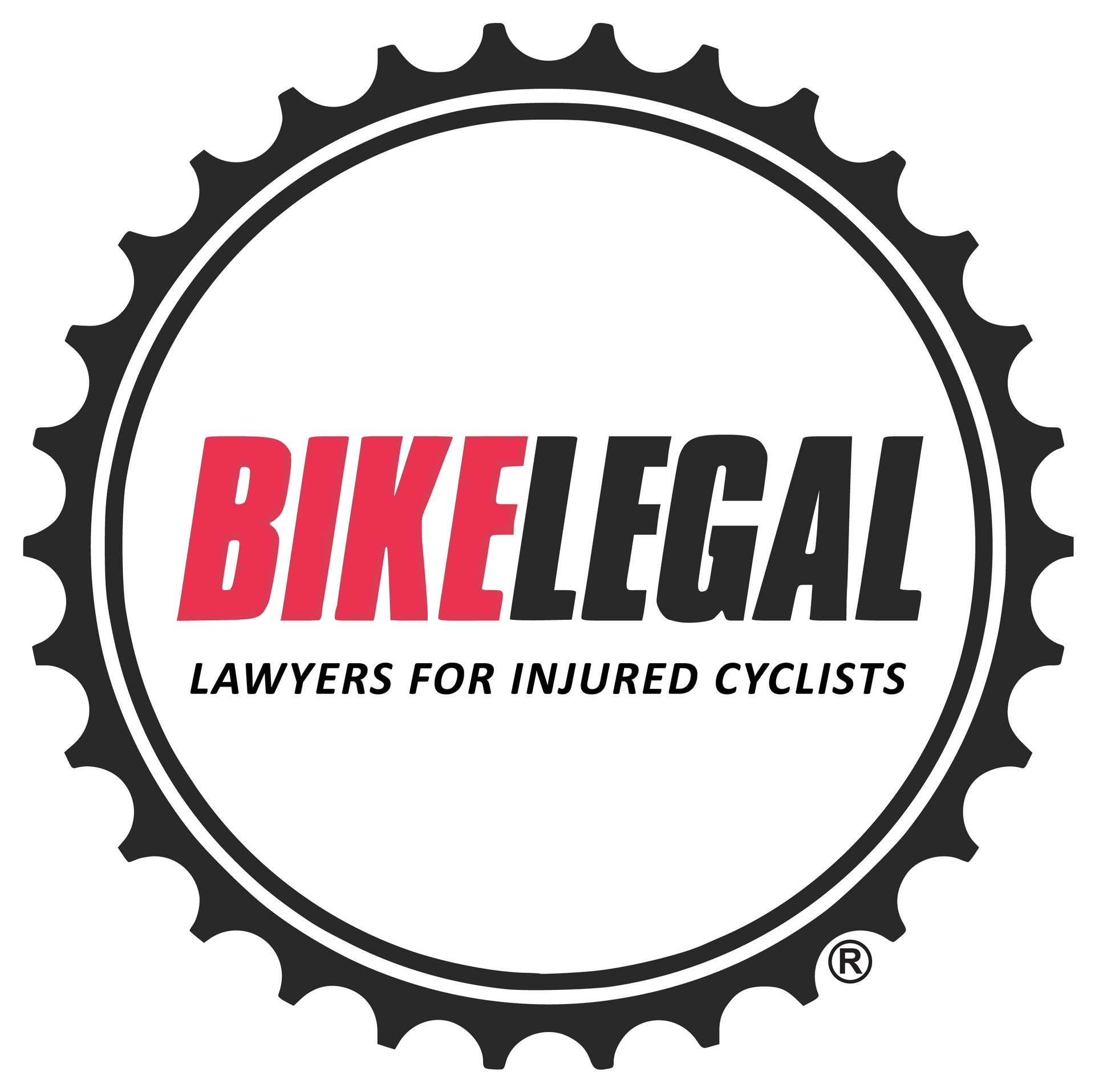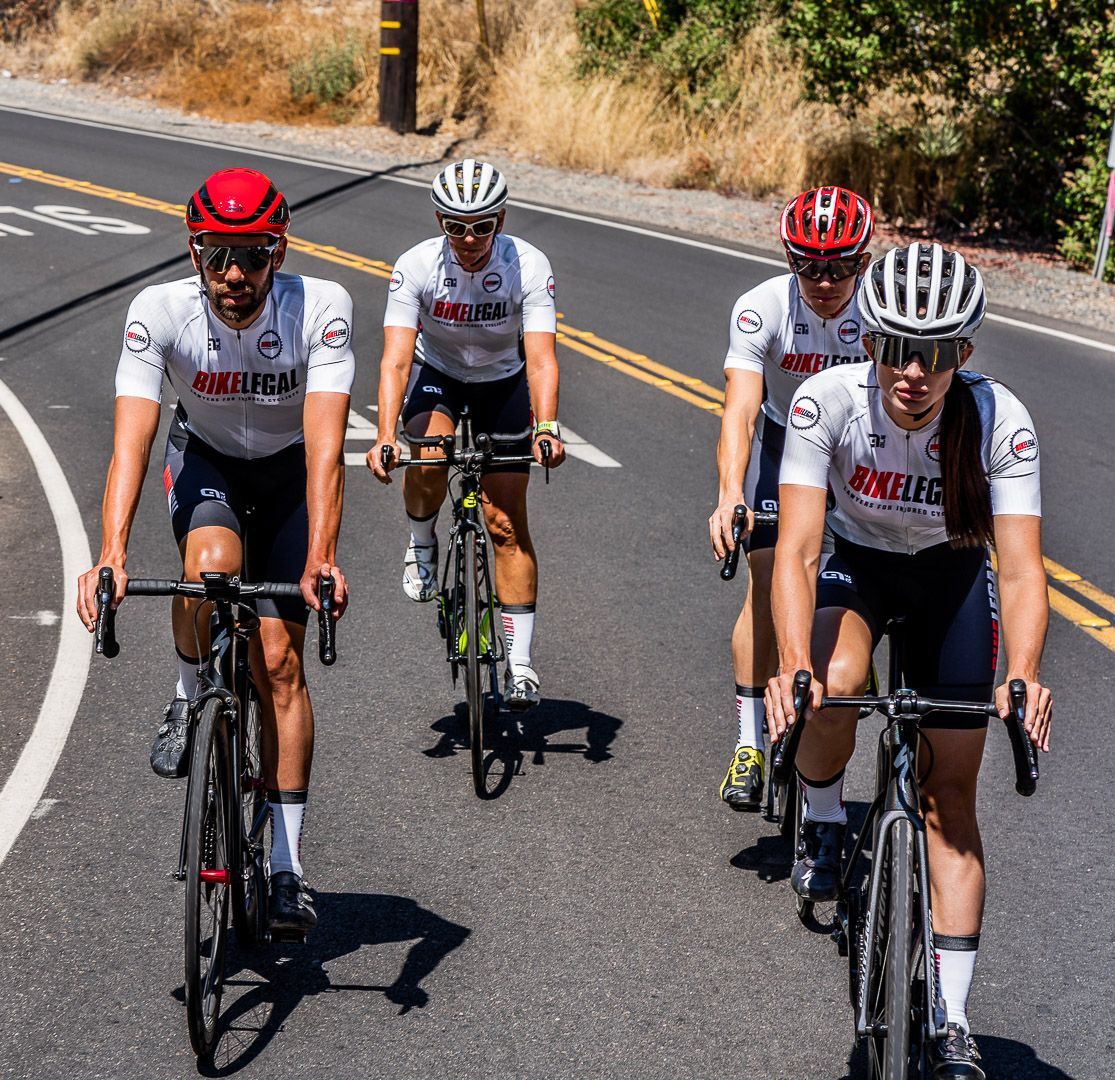California Bicycle Laws and Accident Statistics
Follow us on
social media!
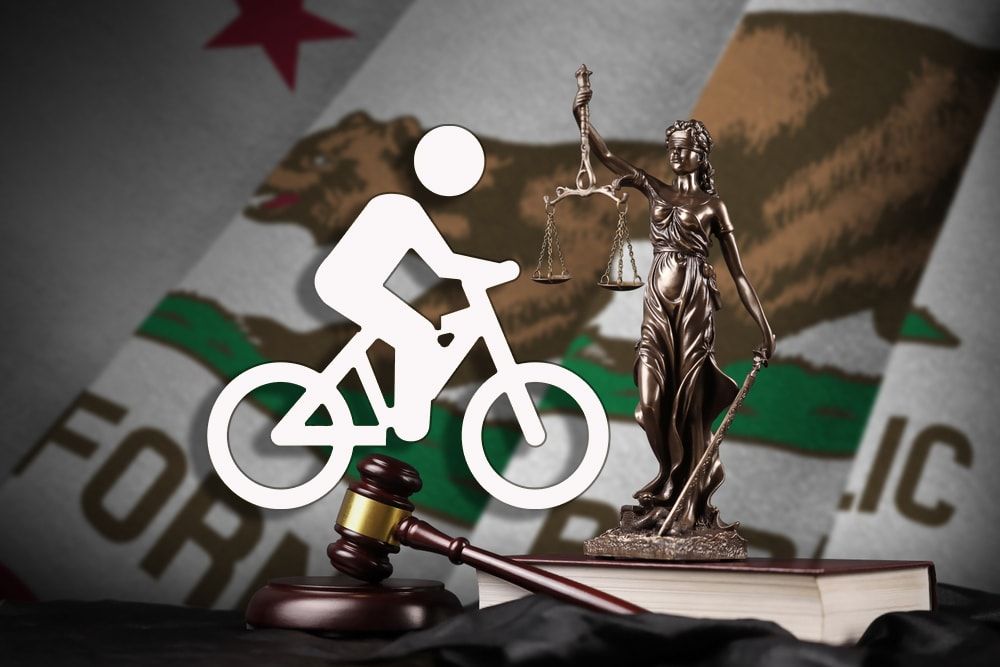
Cycling in California is more than just a popular mode of transportation; it's a way of life for many people. However, with 177 bicyclists killed in California during 2022, understanding and adhering to California's bicycle laws has never been more critical.
As bicycles, e-bikes, and other forms of micro-mobility continue to gain popularity, California lawmakers are actively refining these laws to enhance cyclist safety and address the challenges faced on the road. Staying informed about these regulations and accident statistics is essential for protecting yourself and others while riding.
This article provides a comprehensive overview of California's bicycle laws, accident statistics, and safety recommendations. From understanding the different categories of bicycles and the laws that apply to them, to knowing what to do in the event of an accident, this guide is designed to equip cyclists with the knowledge they need to ride safely and legally in California.
In this guide, we'll cover:
- California's unique bicycle laws that every cyclist needs to know
- Various types of bicycles, E-bikes, and motor-driven cycles
- The ins and outs of road positioning and bike lane usage
- Essential gear and modifications to stay legal and safe
- Fines and penalties for law violations
- Tips for avoiding common pitfalls that lead to accidents and legal issues
Understanding Bicycle Categories in California
California recognizes different categories of bicycles, each with specific rules and regulations. Understanding these categories is crucial for cyclists to ensure they are riding legally and safely.
1. Standard Bicycle
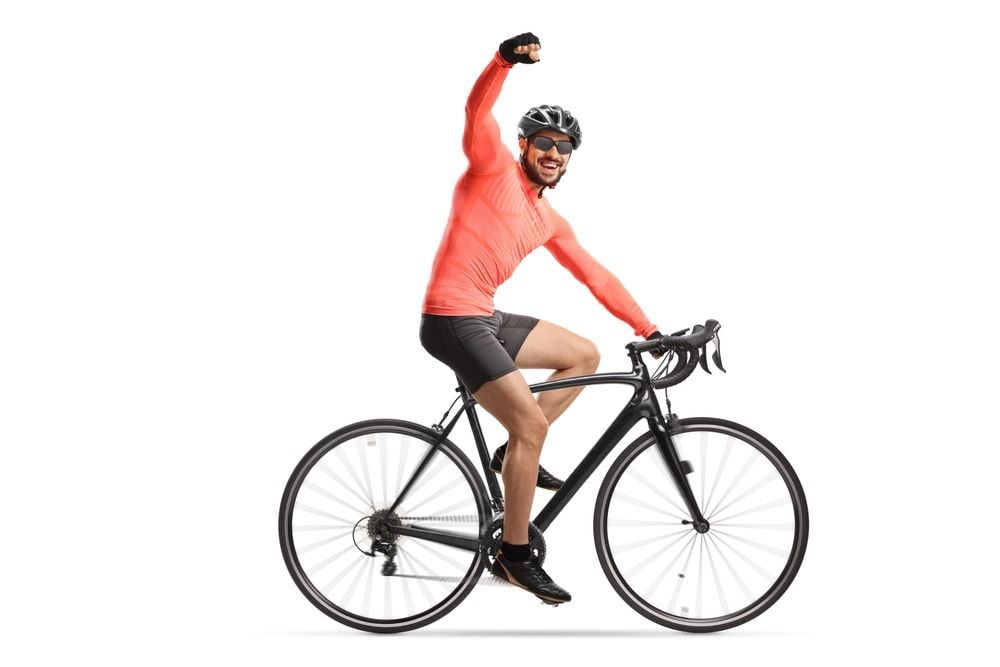
In California, a standard bicycle is defined under Vehicle Code Section 231 as “a device upon which a person may ride, propelled exclusively by human power through a belt, chain, or gears, and having one or more wheels.” This definition encompasses a variety of pedal-powered vehicles, including:
- Standard two-wheeled bicycles
- Tricycles
- Quadracycles
- Tandem bicycles
- Pedal-powered carts
These non-motorized bicycles must comply with general bicycle laws in California. This includes adhering to equipment requirements such as lights, reflectors, and brakes, as well as following rules for lane positioning, helmet use, and other safety regulations. Standard bicycles are commonly used for commuting, recreation, and exercise, and can be ridden on most roads, bike lanes, and paths without special restrictions.
2. E-Bikes (Electric Bicycles)
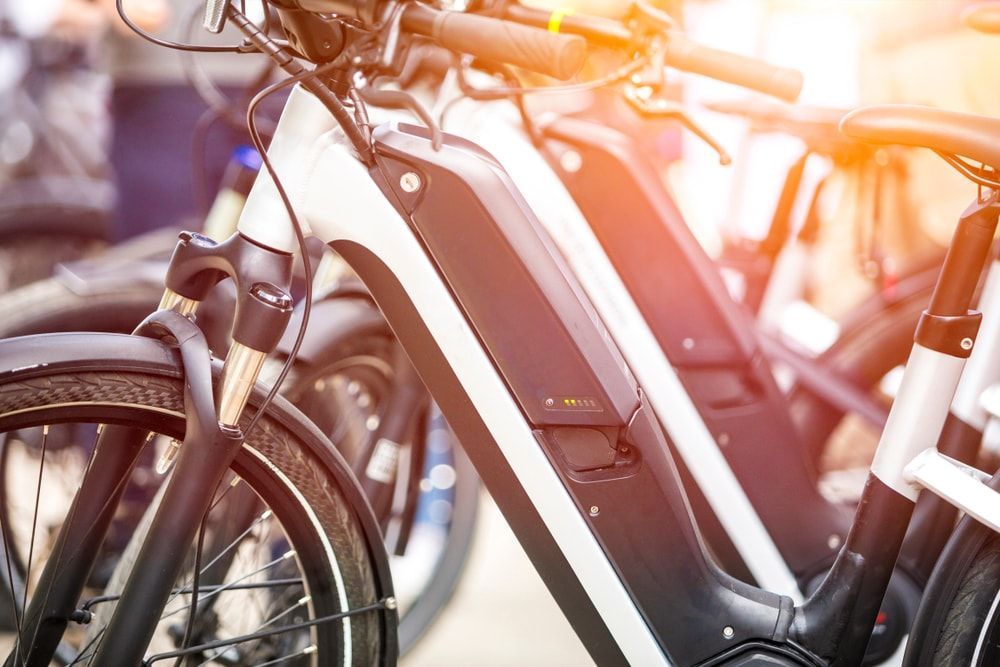
Definition and General Rules
An e-bike, or electric bicycle, is a bicycle equipped with an electric motor that assists the rider while pedaling. The motor provides varying levels of power, making it easier to ride, especially on hills or long distances. E-bikes, or electric bicycles, are a popular alternative to standard bicycles, especially for longer commutes or hilly areas. E-bikes are classified into three categories based on how the motor assists.
California’s E-Bike Classifications
California law classifies e-bikes into three categories based on their operational capabilities:
- Class 1 E-Bikes: These e-bikes provide assistance only when the rider is pedaling and stop assisting once the bike reaches a speed of 20 mph. They are the most similar to standard bicycles and are often allowed on bike paths and trails where motorized vehicles are prohibited.
- Class 2 E-Bikes: Class 2 e-bikes can operate with either pedal assistance or a throttle. Like Class 1, they cease to provide motor assistance at 20 mph. These bikes offer more flexibility, especially for those who may need a break from pedaling.
- Class 3 E-Bikes: These e-bikes provide assistance only while pedaling and allow for higher speeds, with motor assistance ceasing at 28 mph. Due to their higher speed, Class 3 e-bikes have more restrictions: riders must be at least 16 years old, and helmets are mandatory for all riders. Additionally, they are often restricted from certain bike paths and trails.
Who Can Operate an E-Bike?
- Class 1 and 2 E-Bikes: There are no age restrictions for operating Class 1 and 2 e-bikes in California. Riders under 18 must wear a helmet, regardless of the e-bike class.
- Class 3 E-Bikes: Riders must be at least 16 years old, and all riders, regardless of age, must wear a helmet. Additionally, passengers on Class 3 e-bikes are required to wear helmets.
Where Can E-Bikes Be Ridden?
E-bikes can generally be ridden on roadways and in bike lanes, similar to standard bicycles. However, local authorities may impose restrictions on e-bike access to specific paths, particularly equestrian, hiking, or recreational trails. It’s essential for riders to check local regulations before riding in these areas.
3. Mopeds, ZEMS, and Motor-Driven Cycles
Mopeds and Zero-Emission Motorcycles (ZEMS) are distinct from both standard bicycles and e-bikes. Classified by the California Air Resources Board (CARB), ZEMS include a range of vehicles from mopeds and motorized scooters to full-sized motorcycles. Unlike e-bikes, ZEMS do not have pedals and rely solely on motor power. They must be registered with the DMV and are not permitted in bike lanes or on bicycle paths. CARB is actively working on creating incentives for ZEMS as part of California’s broader efforts to transition to clean transportation.
- Requirements:
- Licensing: A motorcycle license (M-1) is required to operate a moped, ZEM, or Motor-driven cycle.
- Registration: Must be registered with the Department of Motor Vehicles (DMV).
- Safety gear: Riders are mandated to wear helmets.
- Insurance: Like motor vehicles, they must be insured.
Understanding the differences between these categories ensures that cyclists in California can make informed decisions about the type of bike they ride and where they are legally permitted to ride it. For more information on motorcycles, motor-driven cycles, mopeds and scooters, please refer to the California DMV
California Bicycle Laws
California has established a comprehensive set of bicycle laws designed to ensure the safety of cyclists, pedestrians, and other road users. These laws cover everything from required equipment and proper riding practices to specific regulations for carrying passengers and operating different types of bicycles, including e-bikes. Whether you're commuting, exercising, or riding for leisure, understanding and adhering to these laws is essential for staying safe and avoiding penalties on California’s roads and bikeways. This section provides an overview of the key bicycle laws every cyclist in California needs to know.
1. Required Bicycle Equipment in California
California Vehicle Code section 21201 outlines specific requirements for bicycle equipment to ensure safety on the road. These regulations are essential for all cyclists operating on public roads, sidewalks (where allowed), and bikeways, particularly during low-light conditions.
- Brakes:
- Every bicycle must be equipped with a brake that allows the rider to make a one-braked-wheel skid on dry, level, clean pavement. This ensures that the cyclist can stop the bicycle effectively in an emergency.
- Handlebars and Bicycle Size:
- Handlebars must not be raised so high that the rider’s hands are above their shoulders when gripping them. This is to maintain control of the bicycle.
- The bicycle must be the right size for the rider, allowing them to stop safely, support the bike in an upright position with at least one foot on the ground, and restart it without difficulty.
- Lighting and Reflectors (for Riding in Darkness):
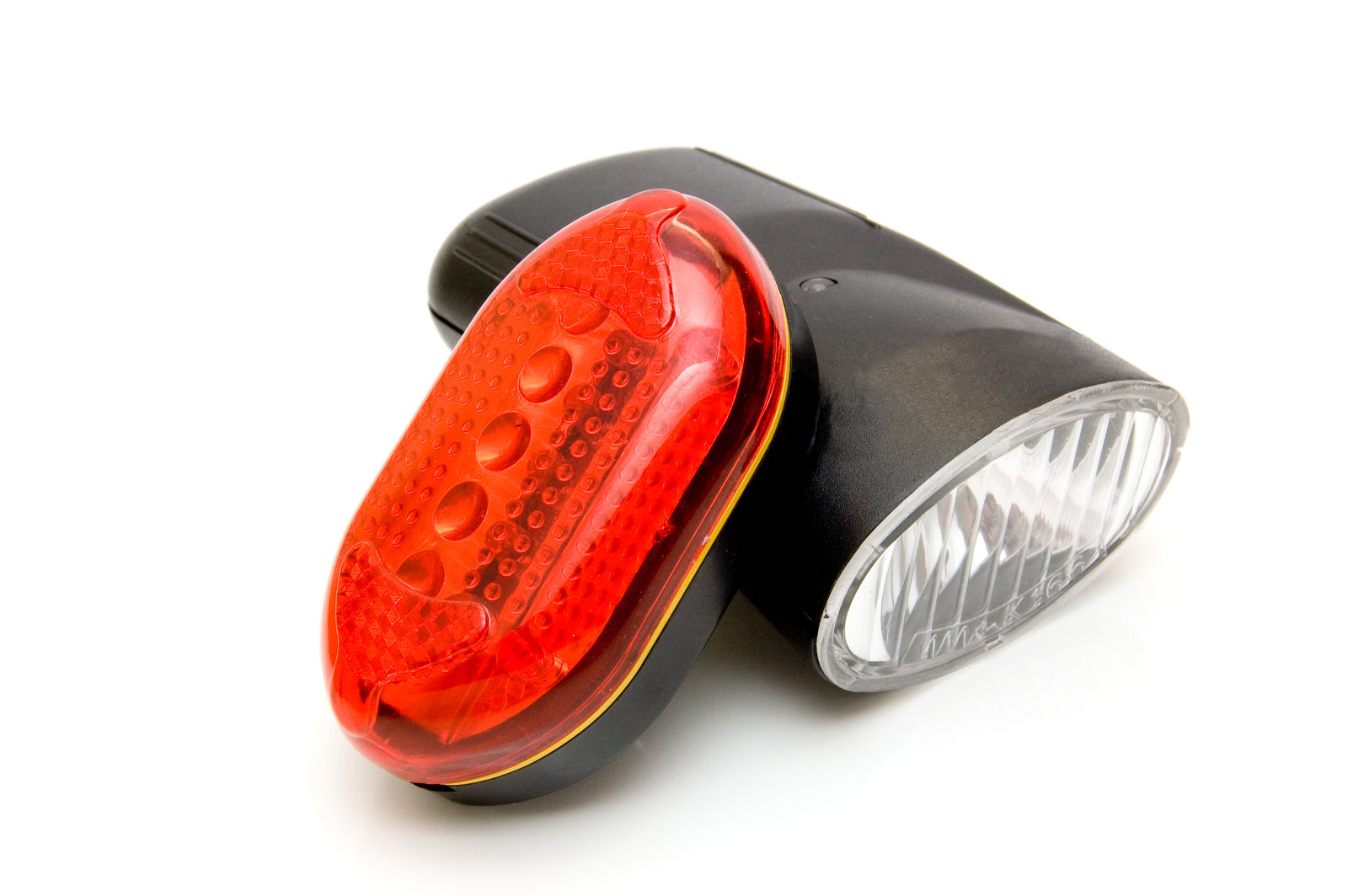
- Front Light: A white light must be used to illuminate the road ahead, visible from at least 300 feet in front and from the sides. This light can be mounted on the bicycle or worn by the rider.
- Rear Reflector or Light: A red reflector or a solid/flashing red light with a built-in reflector must be visible from 500 feet to the rear when illuminated by vehicle headlights.
- Pedal Reflectors: White or yellow reflectors must be attached to each pedal, shoe, or ankle, visible from 200 feet in front and rear of the bicycle.
- Side Reflectors: Bicycles must have white or yellow reflectors on each side forward of the center, and white or red reflectors on each side to the rear of the center. Alternatively, reflectorized tires on the front and rear can replace side reflectors.
- Seat and Passenger Requirements (Section 21204):
- Rider’s Seat: Cyclists must ride upon or astride a permanent and regular seat attached to the bicycle unless the bicycle is designed by the manufacturer to be ridden without a seat.
- Passenger Seats: Passengers are only allowed on a bicycle if they are seated on a separate, attached seat. If the passenger is four years old or younger, or weighs 40 pounds or less, the seat must have adequate provisions to secure the passenger and protect them from the moving parts of the bicycle.
These regulations are designed to enhance safety by ensuring that bicycles are properly equipped and operated in a manner that minimizes risk to both the rider and any passengers. Compliance with these laws is essential for avoiding fines and ensuring a safe riding experience.
2. California Bicycle Helmet Laws
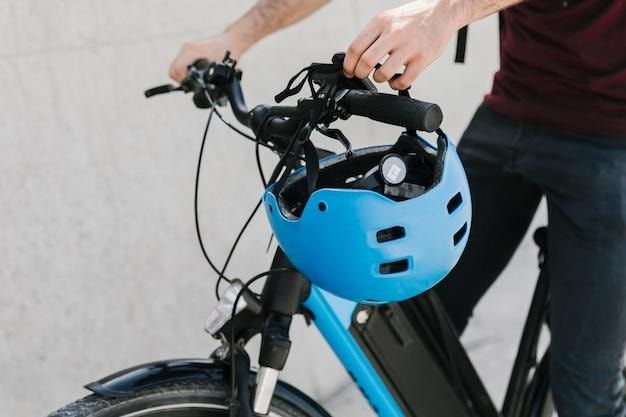
In California, bicycle helmet laws are designed to protect cyclists, particularly younger riders, from head injuries in the event of an accident. The state of California mandates that anyone under the age of 18 must wear a helmet while riding a bicycle on a public road, bike path, or trail. This law applies to all types of bicycles, including standard bicycles, e-bikes, and even scooters and skateboards.
The helmet must be properly fitted and meet safety standards set by the Consumer Product Safety Commission (CPSC). While adults aged 18 and over are not legally required to wear a helmet, it is strongly recommended for all cyclists as a critical safety measure.
Wearing a helmet significantly reduces the risk of serious head injuries in a crash. Studies have shown that helmets can reduce the risk of head injury by up to 85%. Given the potential dangers on the road, including the risk of collisions with motor vehicles, wearing a helmet is a simple but effective way to enhance safety for cyclists of all ages.
It's also important to note that some cities and counties in California may have additional helmet requirements or safety regulations, so cyclists should check local laws to ensure compliance.
3. Sharing the Road, Lane Positioning, and Riding Two Abreast in California
Where to ride, proper lane positioning and understanding the rules for riding two abreast are essential for cyclist safety on California roads. Here's what you need to know:
Sharing the Road and Lane Positioning
- Ride on the right side of the road: VEH 21202 states that bicyclists must ride as close as practicable to the right-hand curb or edge of the roadway when moving less than the average speed of traffic moving in the same direction. However, you may leave the right side if:
- Passing: Moving by slower traffic ahead.
- Turning left: Making a legal left-hand turn.
- Avoiding hazards: Dodging obstacles on the road (e.g., fixed or moving objects, vehicles, bicycles, pedestrians, animals, surface hazards).
- Narrow lanes: When the lane is one way with two or more lanes or is too narrow for a bicycle and a vehicle to share safely. This is known as "Taking the Lane"
- Use a bicycle lane: VEH 21208 requires bicyclists to use bicycle lanes when moving at a speed less than the average speed of traffic moving in the same direction. Exceptions include
- Turning left
- Overtaking another cyclist or vehicle
- Circumventing hazardous situations such as debris in the lane
- Preparing to turn right.
- Freeways and expressways: Under Vehicle Code §21960, the California Department of Transportation prohibits bicycles (including motorized bicycles) on most freeways and expressways. However, some segments may allow bicycles, marked by official signage.
- Obstructing a bike path: VEH 21211 of the California Vehicle Code prohibits the obstruction of bike paths or lanes. It's illegal to stop, park, or leave any vehicle (attended or unattended) on a designated bicycle path.
- Do not cross toll bridges: Under California Vehicle Code Section 23330, bicycles, motorized bicycles, and scooters are allowed on vehicular crossings only under specific conditions. They are only permitted to cross if the department posts official signs indicating that they, or any combination thereof, are allowed on all or part of the crossing.
Riding Two Abreast (side by side): California law does not expressly prohibit cyclists from riding two abreast. However, this should only be done when it does not impede the normal and reasonable flow of traffic.
Here are some situations to consider:
- Speed: Cyclists may consider riding two abreast when they are traveling at the normal speed of traffic. This is especially relevant in situations where cyclists can keep up with the flow of traffic.
- Traffic Flow: If cyclists are not traveling at the normal speed of traffic and are impeding traffic or have five or more motor vehicles behind them, they should ride single file to allow vehicles to pass.
- Lane Width: Cyclists can ride two or more abreast if they are in a lane that is too narrow for both a bicycle and a vehicle to share safely. This helps ensure that cyclists are visible and safe from potential collisions.
- Local Ordinances: It’s important to be aware that some local ordinances may regulate or restrict side-by-side riding. Cyclists should check local laws to ensure compliance.
4. Stopping at Stop Signs and Red Lights (The Idaho stop law)
Yes, bicyclists in California are required to stop at stop signs and red lights, just like motor vehicles. Under California law, bicycles are considered vehicles, and cyclists must obey all traffic signals and signs. This means that when approaching a stop sign or a red traffic light, cyclists must come to a complete stop and yield the right of way to other vehicles and pedestrians as required.
- Stop Signs:
- Cyclists must come to a full stop at stop signs and proceed only when it is safe to do so, following the same right-of-way rules that apply to motor vehicles.
- Red Lights:
- At a red light, cyclists must stop and wait for the light to turn green before proceeding. They are not allowed to proceed through a red light unless making a legal right turn, after coming to a complete stop and ensuring that the way is clear.
- Bicycle Safety Stop (Idaho Stop):
- The bicycle safety stop, also known as the "Idaho Stop," which allows cyclists to treat stop signs as yield signs, is not currently legal in California. Assemblymember Tasha Boerner authored bills in 2021 and 2022 to legalize the bicycle safety stop, but both bills were vetoed by Governor Gavin Newsom due to safety concerns.
- In 2023, Boerner introduced AB 73 in another attempt to make the stop-as-yield law legal for adults on bikes in California. As of now, the bill has passed the Assembly and is moving through Senate committees. Cyclists interested in supporting this legislation should stay informed about its progress and look for opportunities to raise their voices in favor of AB 73.
5. Three Feet for Safety Act
The 21760 Three Feet for Safety Act in California is designed to protect bicyclists by mandating a safe passing distance when vehicles overtake or pass them. This act provides a legal basis for bicyclists to seek recourse in case of a collision or close call resulting from a car's failure to adhere to the three-foot rule.
Key features of the act include:
- Minimum distance for passing: Motorists must maintain a minimum distance of three feet when overtaking or passing a bicyclist traveling in the same direction on the highway.
- Factors for safe passing: The driver should overtake and pass the bicycle in a manner that doesn't compromise the bicycle's safe operation. This includes taking into account:
- The size and speed of motor vehicles and the bicycle.
- Traffic conditions.
- Weather and visibility conditions.
- The width and layout of the highway surface.
- Use another lane when available: If another lane goes in the same direction and is safe and legal, the driver must change lanes to pass the bicycle. This should be done considering overall safety and traffic conditions only if such a lane change is practical and not against traffic laws.
- Penalties: Violating the Three Feet for Safety Act can result in fines to discourage unsafe passing practices. The fine will be $220 if the driver violates the Three Feet for Safety Act, causing bodily injury to the cyclist.
6. California OmniBike Bill
The California Omnibus Bicycle Bill (AB 1909), or "OmniBike Bill," introduces significant improvements for bicyclists in California. Authored Crafted by Assemblymember Laura Friedman, the bill has significantly revised California's vehicle code by implementing four fundamental changes, all of which became effective as of January 1, 2024.
- Change lanes to pass: Building on the 2013 "Three Feet for Safety Act," this new provision mandates vehicle drivers to switch lanes when feasible before passing a cyclist on the roadway, even if the cyclist uses a designated bike lane.
- E-Bikes allowed on all bikeways: The bill opens most California bikeways to Class 3 electric bikes (e-bikes) while allowing communities to restrict them from equestrian and hiking trails.
- Bikes can cross on walk signals: The OmniBike Bill legalizes crossing at intersections during the pedestrian walk signal phase to improve cyclists' intersection safety.
- No more bicycle licensing ordinances: The bill ends the enforcement of bicycle licensing ordinances across the state. These laws were rarely enforced and could be used to harass certain groups, including people of color, selectively.
7. Can You Ride a Bicycle on the Sidewalk in California?
- Sidewalk Riding: The legality of bicycle riding on the sidewalk varies by city or county per California Vehicle Code §21206. In some areas, it's allowed, while in others, it's prohibited or restricted to certain zones (e.g., outside business districts). The following five California cities have banned cycling on sidewalks:
- Carlsbad
- El Cajon
- Escondido
- National City
- Vista
8. Use of Headphones
California Vehicle Code Section 27400 regulates the use of headphones while riding a bicycle to ensure that cyclists remain alert and aware of their surroundings. Here’s what cyclists need to know about using headphones while on the road:
- Legal Restrictions:
- Under California Vehicle Code Section 27400, cyclists are prohibited from wearing a headset, earplugs, or headphones in both ears while riding. This law applies not only to cyclists but also to drivers of motor vehicles and motorized scooters. The purpose of this restriction is to ensure that riders can hear important sounds around them, such as traffic, emergency vehicle sirens, and other potential hazards.
- One Ear Allowed:
- Cyclists are allowed to use headphones in one ear only, leaving the other ear free to hear ambient sounds. This allows riders to listen to music or make phone calls while still being able to hear what’s happening around them, which is crucial for safety.
9. No Hitching Rides
Per California Vehicle Code Section 21203, it is illegal for anyone riding a bicycle, motorcycle, motorized bicycle, coaster, roller skates, sled, or toy vehicle to attach themselves or their vehicle to a streetcar or any other vehicle on the roadway.
This practice, known as hitching, is prohibited because it poses significant safety risks. Hitching can lead to loss of control, accidents, and serious injuries for both the cyclist and other road users. Cyclists should always maintain control of their bicycles independently and avoid the temptation to hitch onto moving vehicles, as it is both dangerous and illegal.
10. Cycling Under the Influence of Drugs and Alcohol
Operating a bicycle under the influence of alcohol or drugs, or both, is prohibited under VEH 21200.5. This law highlights the potential dangers of impaired cycling to cyclists and all road users.
If someone is arrested for biking under the influence, they can ask for a test to check the levels of alcohol or drugs in their system. Violating this code can result in legal penalties, reflecting the seriousness of operating any impaired vehicle.
11. Stop at Crosswalks
According to Section 21950, bicyclists must exercise due care for pedestrians' safety in marked and unmarked crosswalks. This means bicyclists must slow down, stop, and yield the right of way to pedestrians as they approach crosswalks, proceeding only when it is safe.
Pedestrians are also responsible for using due care for their safety, including not suddenly entering the path of a vehicle or unnecessarily delaying traffic while in a crosswalk.
12. Use Hand Signals
California Vehicle Code Section 22111 specifies the proper way to give signals by hand and arm from a vehicle, detailing how these signals should be provided for different maneuvers:
- Left turn: Extend hand and arm horizontally beyond the side of the vehicle.
- Right turn: Extend hand and arm above the vehicle's side. Bicyclists may extend the right hand and arm horizontally to the right side of the bicycle.
- Stop or sudden decrease of speed: Extend hand and arm downward beyond the side of the vehicle.
California Bicycle Accident Statistics
In 2022, California recorded 177 bicycle fatalities, a significant increase from 130 in 2021. This rise may partly be attributed to a change in reporting methodology by the National Highway Traffic Safety Administration (NHTSA). However, California continues to rank among the top 10 states with the highest number of cyclist fatalities per capita.
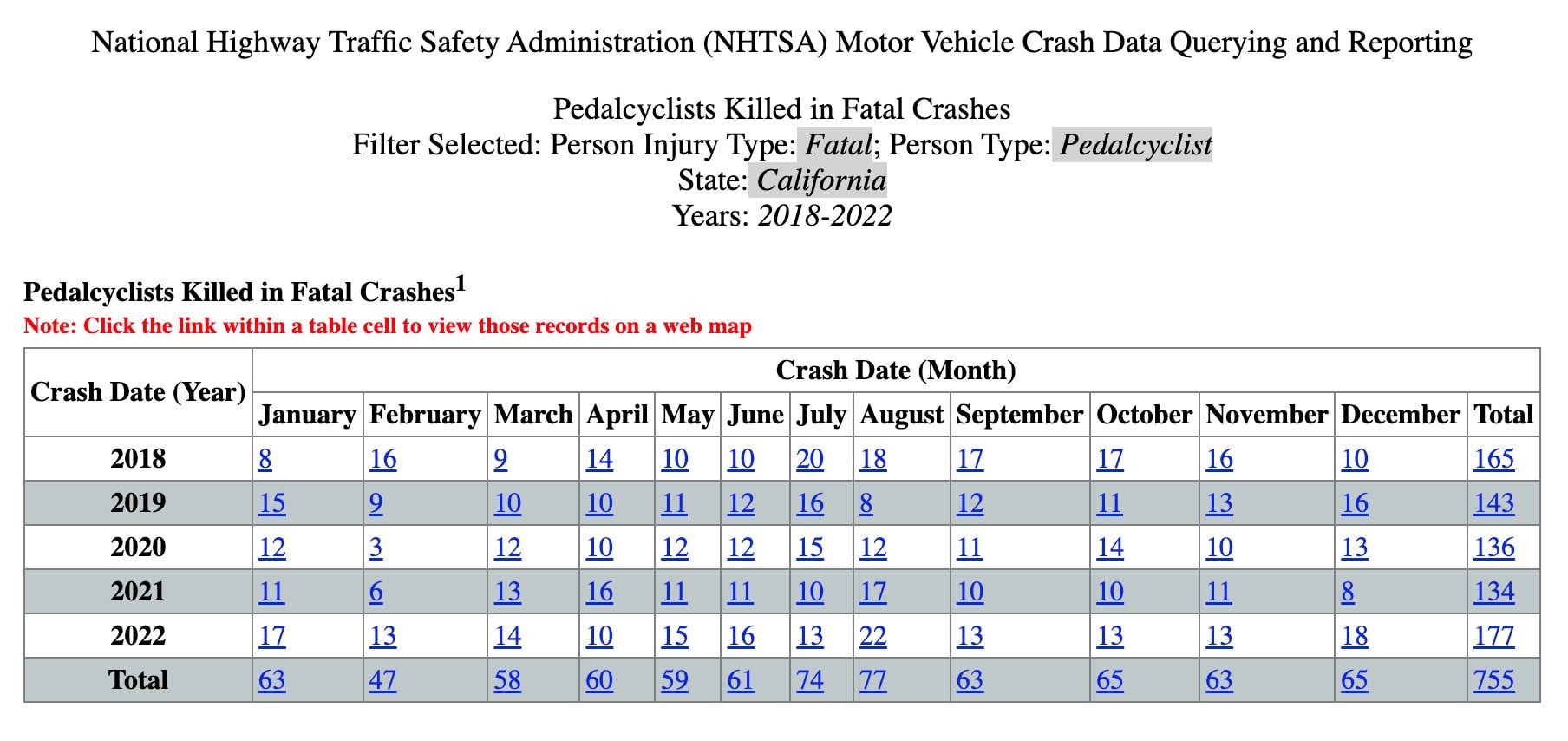
Prior to 2022, motorized bicycles, such as e-bikes, were classified as motor vehicles in the Fatality Analysis Reporting System (FARS) and Crash Report Sampling System (CRSS). Operators and passengers of these motorized bicycles were counted as motorists. However, starting in 2022, these incidents are now categorized under the "pedal cyclist" classification when involved in motor vehicle crashes. As a result, single-vehicle crashes involving only motorized bicycles are no longer captured in these databases, and operators and passengers are counted as pedal cyclists.
This change means that 2022 likely saw the highest number of reported "bicyclist" fatalities historically, but direct comparisons to previous years may not be entirely accurate due to the inclusion of motorized bicycle fatalities under the "bicyclist" category.
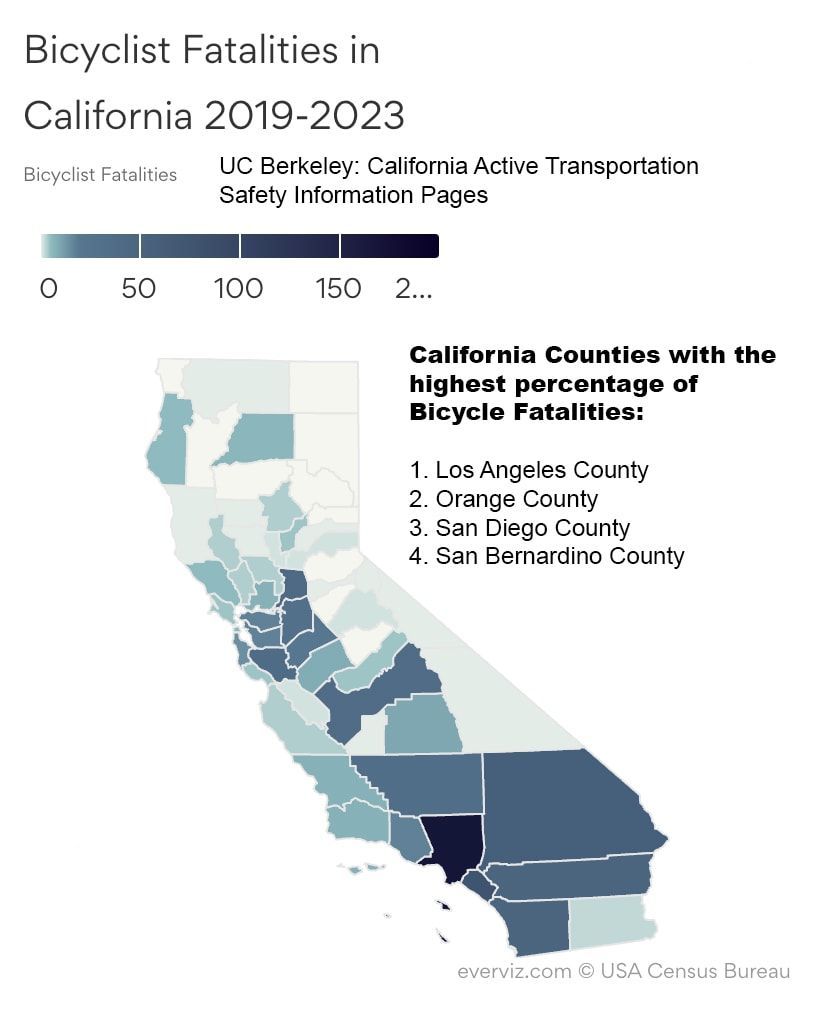
- Males accounted for 88% of bicycle fatalities and 80% of severe injuries in California. The most common age group in crashes was 55-64-year-old cyclists.
- Counties with the highest percentage of bicycle accident fatalities are: Los Angeles County, Orange County, San Diego County, and San Bernardino County
- SWITRS reports on bicyclist injuries have shown fluctuations over the years, with a decrease in injuries from 10,103 in 2019 to 7,941 in 2021.
- In California, during 2021, bicyclists accounted for 2.9 percent of all motor vehicle-related deaths.
- California, along with states like Florida and Texas, accounted for nearly 41 percent of cyclist fatalities in the United States between 2014 and 2017.
The Need for Uninsured or Underinsured Motorist (UM/UIM) Coverage
In a bicycle accident, the financial impact can be as significant as the physical injuries. With the Insurance Research Council reporting a 16.6% uninsured motorist rate in California as of 2019, the risk of an accident with an uninsured driver is not negligible.
This is where Uninsured/Underinsured Motorist coverage becomes essential for bicyclists.
- Uninsured motorist (UM) coverage: It is your safeguard when the at-fault driver does not have insurance. It can be added to your auto or motorcycle policy, protecting against injuries and damages that exceed the at-fault driver's insurance limits. The minimum coverage limits in California are
- $15,000 in case of bodily injury or death/person
- $30,000 in case of total bodily injury or death/accident
- $5,000 in case of property damage to the other vehicle.
- Underinsured motorist (UIM) coverage: Similarly, UIM coverage is your backup when the at-fault driver's insurance falls short. Bicycle accidents can result in substantial damages, and it's not uncommon for the responsible party's policy limits to be inadequate. UIM coverage allows you to file a claim with your insurer to cover the additional expenses, ensuring you're not left financially vulnerable.
Advantages of UM/UIM coverage for California bicyclists
Uninsured/Underinsured Motorist (UM/UIM) coverage is an invaluable asset for California bicyclists, offering comprehensive financial protection due to several key benefits:
- Medical expense coverage: UM/UIM policies provide crucial funds for medical treatments following an accident with drivers lacking sufficient insurance coverage.
- Lost wage compensation: If injuries from a collision prevent a cyclist from working, this coverage compensates for the loss of income during recovery.
- Pain and suffering reimbursement: These policies often extend to alleviate the non-economic toll of an accident, covering both physical discomfort and emotional suffering.
- Protection in hit-and-run incidents: In the unfortunate event of a hit-and-run, UM/UIM coverage serves as a safeguard, compensating you as if the fleeing driver was uninsured.
- Customizable coverage limits: Policyholders have the flexibility to select limits that align with their personal sense of the necessary protection level.
- Family member inclusion: The protective umbrella of UM/UIM coverage typically extends to family members, providing them with the same level of security under the policy.
Tips for Safe Bicycling in California
Here are concise tips to help you avoid accidents and legal issues while cycling in California:
- Obey traffic laws: Follow motorists' rules, including signaling turns and stopping at signs.
- Use bicycle lanes: Ride in designated lanes or on the right-hand side of the road.
- Wear a helmet: This is required for riders under 18 and is recommended for all.
- Be visible: Use bike lights and reflectors at night and in low-light conditions.
- Signal intentions: Use hand signals for turns and stops.
- Avoid distractions: No headphones or mobile devices while riding.
- Check equipment: Regularly inspect your bike's brakes, tires, and lights.
- Ride defensively: Stay alert to cars, pedestrians, and other cyclists.
- Understand right-of-way: Yield to pedestrians and follow intersection rules.
- Keep a hand on the handlebars: During maneuvers, maintain control by keeping at least one hand on the handlebars.
- Avoid sidewalks: Check local laws, as riding on sidewalks may be illegal.
- Take a bicycle safety course: Consider learning more about safe riding and maintenance.
Penalties and Fines for Violating Bicycle Laws in California
Violating bicycle laws in California can result in penalties and fines, similar to violations involving motor vehicles.
Let’s explore some common violations and their associated penalties:
- Running a red light or stop sign: Cyclists are required to obey traffic signals and signs. Running a red light or stop sign can result in a citation, typically with fines ranging from $100 to $250.
- Not wearing a helmet: If you are under 18 in California, you must wear a helmet while riding a bike. Failure to do so may result in a citation or fine of up to $25.
- Cycling under the influence penalty: A misdemeanor with a $250 fine for riding on public roads, paths, or highways while under the influence of alcohol, drugs, or both, as per Vehicle Code § 21200.5 VC.
- Violation of driving with headphones: Violation of Code 27400 can result in penalties for motor vehicle drivers and bike riders. Violators face a $197 fine and one DMV point.
California Ranking for Cycling
Despite being among the top 10 states for bicycle fatalities, California was recognized as the fourth most Bicycle-Friendly State in the nation by the League of American Bicyclists. This ranking is based on the state's performance across five key bicycle-friendly categories:
- Infrastructure & funding: California has earned a 'B—' grade, reflecting significant but improvable efforts to use federal and state transportation funding to build and maintain bicycle infrastructure.
- Education & encouragement: California achieved a 'B' in this category. It is recognized for its advocacy, state goals to increase cycling, and sponsorship of conferences on biking, which demonstrate a proactive approach to cyclist education and encouragement.
- Traffic laws & practices: The state shines with an 'A' grade here, highlighting robust traffic laws related to cyclist safety and practices for automated enforcement, alongside efforts to prevent racial disparities in traffic law enforcement.
- Policies & programs: California’s Complete Streets policies and programs that support biking improvements receive another' A' grade, reflecting a robust institutional framework for cycling support.
- Evaluation & planning: California's strategic approach to cycling, including safety outcomes, public engagement, and data collection on biking and walking, is characterized by an A' in evaluation and planning.
Rankings of California Cities in the 2023 U.S. Bicycle Network Analysis
California's cities performed strongly in the 2023 U.S. Bicycle Network Analysis, with several cities leading the rankings in their respective size categories. This analysis, which evaluated 1,484 cities nationwide, assigned scores based on the quality of bike networks.
Cities were scored on a 0-100 scale, where a score of 80-100 signifies excellent bike accessibility for all ages and abilities, and a score below 20 suggests significant room for improvement.
Here's how California cities stacked up:
- San Francisco, CA: With a score of 63, San Francisco ranks as the second-best large city for cyclists in the U.S. The city's comprehensive network of bike lanes and bike-friendly policies affirm its commitment to providing a safe and accessible biking environment.
- Davis, CA: Davis leads medium-sized cities with a remarkable score of 77, setting a high standard for bicycle network quality and accessibility.
- Berkeley, CA: Berkeley follows closely, scoring a robust 72, reflecting its extensive bike network and supportive cycling culture.
California Advocacy Groups for Bicyclists
California is home to a dynamic network of state advocacy groups that strive to protect and promote cyclists' interests. These organizations are pivotal in advancing cyclist rights and enhancing roadway safety for the biking community.
Here are some prominent advocacy groups in California that are at the forefront of promoting cycling safety and awareness.
1. CalBike: California Bicycle Coalition
- Mission: CalBike works to enable Californians to lead healthier lives through bicycling, advocating for equitable, inclusive, and prosperous communities.
- Activities: CalBike unites local, statewide, and national partners to work for better biking across California. They engage in legislative advocacy, provide resources for e-bike users, and have campaigns like Complete Streets to ensure road safety for cyclists.
2. CABO: California Association of Bicycling Organizations
- Mission: CABO has been involved in cycling advocacy since the early days of modern bicycling, experiencing the ebb and flow of cycling popularity and infrastructure development.
- Activities: The organization emphasizes education through programs like Smart Cycling sessions, which offer cyclists knowledge on safe riding practices on roadways.
California’s Major City Advocacy Groups
In the major cities across California, there are key advocacy groups that focus on local issues and initiatives to create safer and more enjoyable cycling environments.
1. Los Angeles: Los Angeles County Bicycle Coalition (LACBC)
- Mission: Bike LA aims to transform Los Angeles County into a thriving environment for cyclists through advocacy for safer roads, improved infrastructure, and cyclist-friendly policies.
- Activities: Members are encouraged to participate in group rides exploring Los Angeles, engage with local chapters for community and advocacy events, and contribute through volunteer work to support cycling initiatives.
2. San Francisco: San Francisco Bicycle Coalition (SFBC)
- Mission: SFBC is dedicated to making San Francisco a premier city for cycling, enhancing safety, accessibility, and street infrastructure to ensure cyclists' comfort and integration into the urban landscape.
- Activities: The coalition engages in policy advocacy, educational programs, and community events to promote cycling benefits and foster a strong, informed, vibrant biking community.
3. San Diego: San Diego County Bicycle Coalition (SDBC)
- Mission: SDBC is committed to transforming San Diego County into a safer and more enjoyable area for cycling, focusing on advocacy for better infrastructure and policies to protect cyclists' rights.
- Activities: SDBC's efforts include pushing for new cycling routes, educational programs on bike safety, and organizing community events like Women+ on Wheels and San Diego Design Week to promote cycling culture.
4. Sacramento: Sacramento Area Bicycle Advocates (SABA)
- Mission: SABA is a group dedicated to promoting cycling and advocating for safer infrastructure in the Sacramento region.
- Activities: They focus on improving bike infrastructure, hosting community events, providing maintenance checks, promoting e-bikes, facilitating bike donations, providing lights for safety, and offering skills training.
What to Do If You've Been Involved in a Cycling Accident in California?
It's important to know what steps to take if you've been involved in a cycling accident in the Golden State.
Let's explore some essential steps tailored to the laws and resources in California:
- Seek medical attention: The first and most important step after a cycling accident is seeking medical attention. Assess your injuries and mental state.
- Contact 911: In California, it is required by law to report any accident involving injuries or property damage exceeding $1,000 to the police. Ensure that clear information is provided to the paramedics and ask the police to create a traffic collision report.
- Gather information: Gather information at the accident scene, including the names and contact information of all parties involved and any witnesses. Take photos of the accident scene, including any damages to your bike or injuries you sustained.
- Preserve evidence: Use your phone to take photos of your injuries, bike, and the accident scene. Keep detailed notes of the incident, including the date, time, location, and how the crash happened. Maintain your clothing and gear for evidence and document the state of your bike before repairs.
- Contact a bicycle accident attorney: If you've been injured in a cycling accident, you must contact an attorney experienced in handling these cases. A knowledgeable attorney can help you navigate the legal process and ensure you receive the compensation you deserve.
Why You Need a California Bike Accident Attorney?
Navigating the aftermath of a bicycle accident in California requires more than just essential legal assistance. An experienced bike accident attorney brings specialized expertise to the table, which can be crucial for your recovery journey, both physically and financially.
Here’s why securing a California bike accident lawyer is critical:
- Expertise in state laws: They are experts in California’s specific traffic laws affecting cyclists, providing precise legal advice to protect your rights.
- Dealing with insurance companies: Their seasoned experience with insurance negotiations can help ensure insufficient settlement offers do not sideline you.
- Investigative capabilities: With the right resources to examine and gather evidence, they can build a robust case to support your claim.
- Insight into cycling culture: A bike injury lawyer who understands the cycling community can more effectively communicate the nuances of your case.
- Skilled litigation: They are proficient in the courtroom and at the negotiation table, and they can help you resolve your claim favorably.
If you have been affected by a bicycle accident and are looking for the best bicycle accident attorney in California, consider Bike Legal, a cycling accident law firm, for a free consultation. Our team of specialized bicycle accident attorneys understands the intricacies of California's cycling laws. It offers the support and expertise needed to pursue the justice and compensation you are entitled to.
We aim to help alleviate the burden during this challenging time so you can focus on what matters most: healing and recovery.
Had a Bicycle Accident? Get Professional Support from Bike Legal!
Call 877-BIKE LEGAL (877-245-3534) or submit our contact form to schedule a free case evaluation.
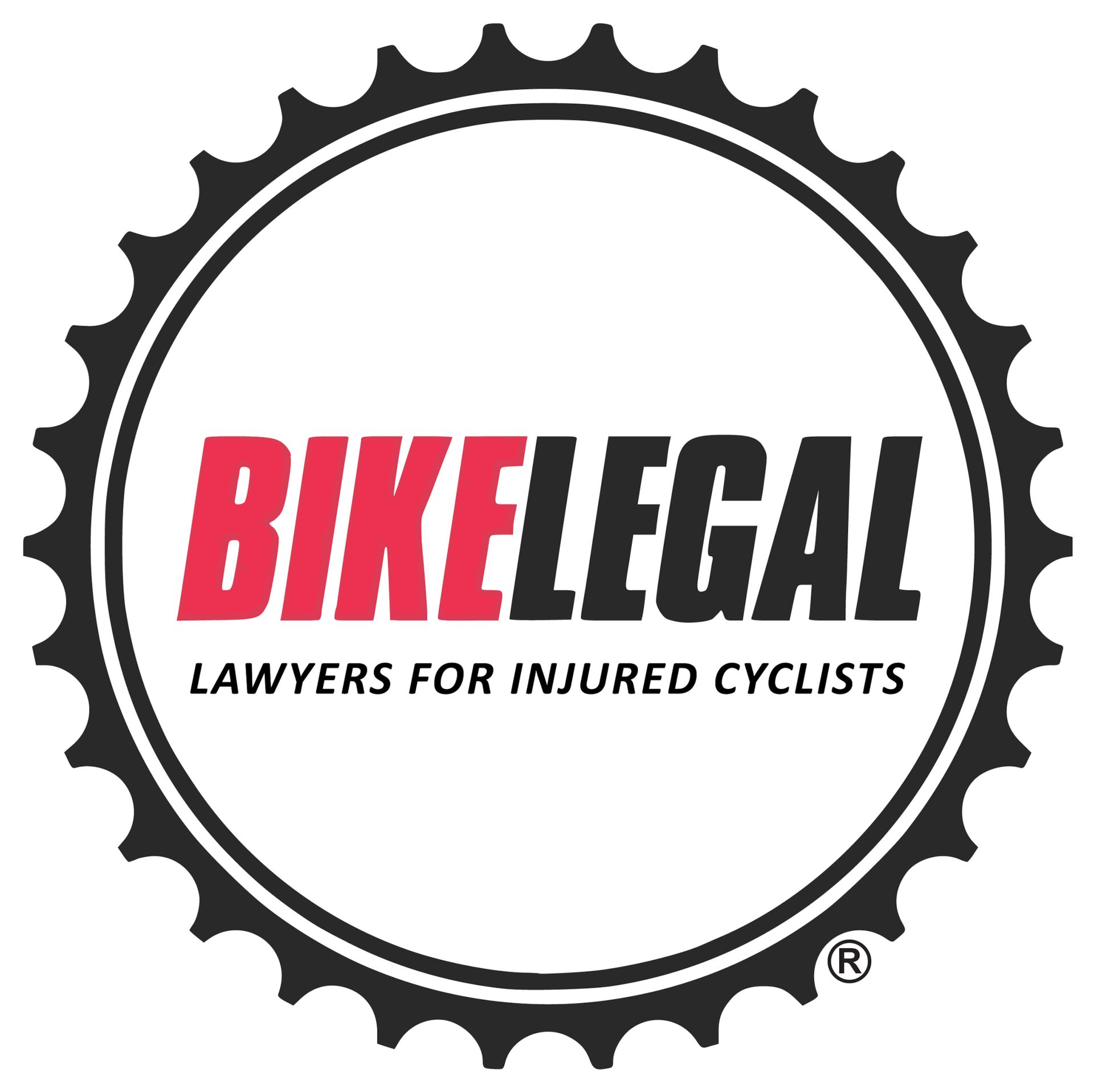
Frequently Asked Questions (FAQ's)
Is it illegal to ride a bike on the sidewalk in California?
Under California Vehicle Code §21206, bicycle riding on the sidewalk is legal in different cities or counties. While some areas permit it, others ban it entirely or restrict it to specific zones, such as outside business districts. Notably, Carlsbad, El Cajon, Escondido, National City, and Vista have particular bans on cycling on sidewalks.
Can I ride my bike in a crosswalk in California?
Yes, you can ride your bike in a crosswalk in California, but the law requires bicyclists to yield the right-of-way to pedestrians within marked or unmarked crosswalks. Cyclists are advised to dismount and walk their bikes when using pedestrian crosswalks, especially in busy areas, to enhance safety for everyone.
Are bicycle helmets required in California?
In California, all bicyclists and passengers under 18 are legally required to wear a bicycle helmet that meets the safety standards of the CPSC or ASTM. Although it's not mandatory for adults 18 and over, wearing a helmet is strongly recommended for all cyclists regardless of age for increased safety.
Read Next:
